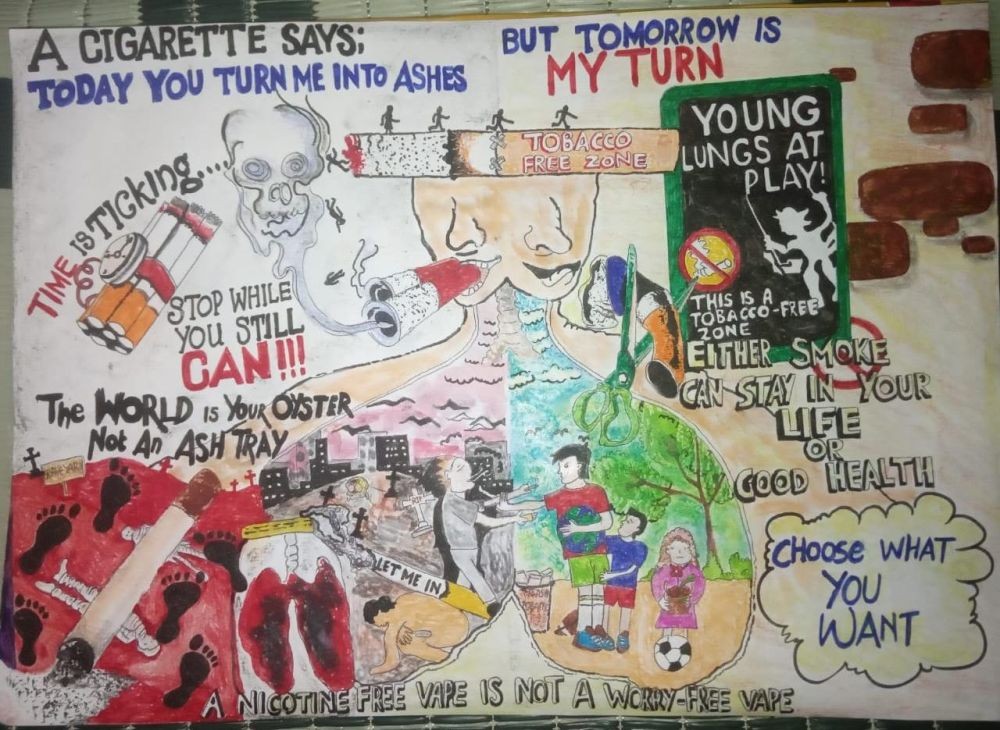Atsala S Sangtam’s poster was adjudged 1st position during the World No Tobacco Day online poster campaign initiated by MSK, Sakhi-OSC in collaboration with District Administration & NTCP, Kiphire in May 2020. (Photo Courtesy: twitter@DCkiphire)

Dimapur, August 20 (MExN): Can Youth, Dimapur hosted a state level workshop (webinar) on WHO FCTC Article 5.3 for senior government officials and national experts in collaboration with National Tobacco Control Programme (NTCP) and State Tobacco Control Cell (STCC) supported by The Union, New Delhi on August 19.
Dr Meribeni Odyuo, Deputy Director and State Programme Officer, National Oral Health Programme, Directorate of Health & Family Welfare (DoHFW) presented a pilot study conducted by NTCP Nagaland, 2020 report where she mentioned that the consumption of pan masala by the young are very high.
She presented the tobacco profile in 8-13 years age group in schools under National School Oral Health Survey 2013-2014, where 28.3% are already in tobacco habits, 15% smoking and 41.2% buy tobacco products for parents or elders. She showed another concern that 47.6% are smokeless tobacco users.
She encouraged the participants to continue intensive awareness strategy, effective enforcement at the government and non-governmental level, and enforcement level and most importantly everyone should be positive activist and a role model.
Around 44% prevalence of tobacco users in Nagaland
Dr Rana Jugdeep Singh, Deputy Regional Director and NCD Control, The Union, New Delhi took a session on the challenges and opportunity of implementation of WHO FCTC article 5.3 guidelines to strengthen tobacco control laws in the state.
A press release stated that Dr Rana mentioned, ‘Nagaland does not produce any tobacco crop as well it is not producing any tobacco product which is a good thing and which is why it has become more important for Nagaland to ensure on issue of tobacco in state where there is no tobacco industry but still very high in consumption of tobacco in those states due to the interference which happens whenever we have tobacco users.’
Dr Rana shared that prevalence of tobacco in Nagaland is third from top with 43 or 44 per cent as per the Global Youth Tobacco Survey of 13 to 15 years of age. He said that COVID-19 has given us an opportunity to strengthen FCTC Article 5.3 where many states have stopped tobacco consumption. He concluded his session by encouraging the people of Nagaland to have a tobacco free generation and for that preventing tobacco industry is very crucial.
‘Stakeholders need to put efforts together’
Dr Chiekroshuyi Tetseo, Jt Director and State Nodal Officer, NTCP, DoHFW gave a brief summary of COTPA 2003. He also explained on the objective of WHO FCTC which is to empower the member countries to come up with strong anti-tobacco laws and make efforts to protect them from the interference of tobacco industry. He highlighted on Article 5.3 of FCTC as this article calls to limit interaction between law makers and the tobacco industry.
He said that stakeholders such as police, drug control department, Food Safety and Standard Authority of India (FSSAI) Act 2006, Legal Metrology Rule Officers, Municipal Affairs and Urban Bodies, Juvenile Justice Care and Protection of Children, Plastic Waste Management and Education Department can play an important role to contribute in tobacco control in the state.
“All the stakeholders need to put our efforts together in strengthening public health measures and to reduce deaths and diseases burden in our society,” Dr Chiekroshuyi stated.
WHO FCTC Article 5.3
Dr Amit Yadav, Senior Technical Advisor, The Union, New Delhi spoke on WHO Framework Convention on Tobacco Control (FCTC) obligations and India’s journey in advancing policies to protect government policy to protect government policy from tobacco industry interference.
He mentioned that India ratifies FCTC on 2003 and now it is applied to 182 countries. He shared the guidelines for effective implementation of FCTC and mention that Article 5.3 “Protection of tobacco control policies from the tobacco industry” was adopted in the years 2008. For safety of public health advertising of tobacco products through banners and boards in shops should be removed, he said.
Mentioning that India was ranked at no. 72 in Asia Tobacco Industry Interference Index, 2017 and reduced to 69 in 2018 and again reduced to 61 in 2021, Dr Amit said that any activities directly or indirectly advance the interest of tobacco industry and talking against the public health policy and against the tobacco control policy that is adopted by government and STCC is a tobacco interference.
Jenpu Rongmei, Founder and Chief Functionary, Can Youth delivered the vote of thanks while the session was moderated by Sentiwati, Project Coordinator, Development 4 Adolescent, Can Youth and welcome address was delivered by Katini Eshena, Facilitator, Can Youth.





